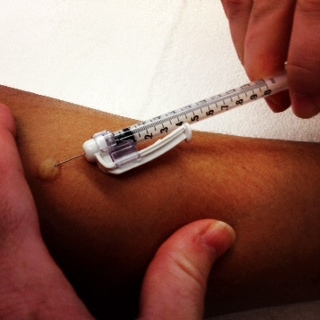What is the cost?
There is no fee for the TB skin test for medical purposes. Proper documentation must be brought from the health care provider who is requesting the test.
Back to top
Who should have a TB skin test?
People who have:
- been recently exposed to someone with active TB
- a medical condition or take medication that affects their immune system (e.g., HIV or Diabetes)
People who:
- are immigrants, refugees or travelers from areas with a high incidence of TB
- work at, or are residents of, health care facilities, homeless shelters, or correctional facilities (see healthcare provider)
- live or work in Aboriginal communities with high rates of TB
Back to top
Who should not have a TB skin test?
Anyone:
- With a reliable history of being TB skin test positive in the past.
- With a history of active TB in the past or history of treatment for inactive or active TB in the past.
- Who is allergic to any component of the Tubersol ® or any vaccine that has the same components as Tubersol ® which includes phenol.
- With extensive burns, eczema or other skin lesions where the TB skin test is to be given
- Who has had a live virus vaccine (e.g. MMR, shingles, or chickenpox) 4 weeks before the TB skin test is to be given. This is because the live vaccines can reduce the immune response to the TB skin test. A TB skin test can be done on the same day as live vaccines.
- With a major viral illness (e.g. mononucleosis, mumps, measles) in the past month. Anyone with the common cold in the past month can receive their TB skin test.
The following are not contraindications for TB skin testing and the person can still be tested if they:
- Are pregnant
- Are breastfeeding
- Have a history of BCG vaccination
- Have been vaccinated with a non-live vaccine in the past 4 weeks (including COVID-19 vaccine) or have received treatment with low-dose steroids
Back to top
What is a one-step TB skin test?
A “one-step” TB test (PDF 130KB) requires that you come in for the test, and return 48-72 hours later during clinic hours to have it read (the nurse looks at your arm to determine if it is positive or negative). If you arrive more than 72 hours later the test cannot be read, as the result is no longer valid.
Back to top
What is a two-step TB skin test?
The “two-step” TB skin test (PDF 130KB) involves a first step and reading as described above, and then it is repeated again, at least 1-4 weeks later* if the first TB skin test was negative. This step also requires you to return in 48-72 hours to have it read. If either the first or second step was positive, you will need a medical examination and chest x-ray to be sure you are not sick with active TB. For people who may need to have routine TB screening because of their work or other risk factors, only the initial testing should be a two-step. Once a baseline is established, further TB skin testing should only require one-step.
*The two-step TB skin test should normally be given as a series of two single TB skin tests repeated between 1-4 weeks apart. However, two individual TB skin tests performed 4-52 weeks apart are also considered an acceptable “two-step TB skin test” (Canadian Thoracic Society & The Public Health Agency of Canada, 2013)
Back to top
What does a positive skin test mean?
A positive skin test does not mean that you are sick with tuberculosis. In most cases, all it means is that you may have been exposed to the tuberculosis germ at some time during your life.
If you have a positive skin test, you will need a medical examination and chest x-ray to be sure you are not sick with tuberculosis. Your doctor may want to put you on some medication to prevent inactive TB from turning into active TB.
If you have had a positive test, it is important that you not get any further TB skin tests in your lifetime as they will continue to be positive. If you are asked to get another TB skin test for school, work or volunteering, see your doctor to get a chest x-ray done instead.
Back to top
